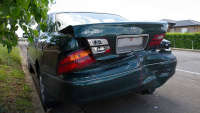Pumping up and maintaining the pressure of your car tyres is one of the most important things you can do.
Tyres provide a vital link with the road, one that properly maintained gives us the ability to steer, brake, corner and accelerate.
They also help determine the fuel economy we value so highly, but most importantly they keep us out of trouble.
The best things about checking and maintaining the inflation pressure is that it is easy and it's free.
Where can I do it?
Every service station has a pump you can use to both check and inflate your tyres. It's easy to use, it can be done in a minute or two, and there's no charge.
The pump is usually located away from the petrol pumps so you won't delay anyone else while you do it, and it usually has signs to allow you to identify it.
If you're not sure ask the service station attendant.
Tyre retailers also have pumps and they're usually happy to let you check your tyre pressures, and for a smile they might even do it for you.
When should I do it?
Tyre pressures should be checked at least once a month, and the best time to do it is when the tyres are cold. That's in the morning before you motor out of your driveway.
Checking the pressures cold gives you the most accurate reading of the inflation pressures; the pressures will climb as the tyres warm up and you'll then get an incorrect reading.
If you can't check the pressures before you drive away head to the nearest service station and do it there.
What pressure should I use?
The recommended inflation pressures are displayed on a sticker attached to your car's body.
It's usually in the driver's door opening, but could also be inside the fuel filler cap, or on the inside of the glove box lid.
-wide.jpg)
If you're not sure the pressures are also shown in the owner's manual.
The inflation pressures given are the cold settings and they are usually shown in metric kPa or the equivalent imperial psi.
Pressures are given for normal driving and also for when you've got a load in the boot or when travelling at high speed.
Can I use higher than recommended tyre pressures?
The recommended pressures are a compromise designed to achieve the best combination of safety, comfort, handling and braking, and fuel economy.
Deviating from those recommendations will affect one or more of those things, so carefully consider the consequences before deciding to set your inflation pressures higher or lower.
Setting the pressure a little higher can result in improved fuel economy and handling, but can make your car ride less comfortably.
How do I check my tyres?
After locating the pump at your service station, check to see what the displayed pressure setting is and reset it to the pressure recommended for your car.
Remove the dust caps from the valves on your tyres and slip the hose fitting over the valve stem and release the clasp so that it attaches to the stem.
The pump will automatically adjust the pressure to the level you have set and an audible signal will tell you when it has reached that pressure.
-wide.jpg)
Release the clasp and remove the hose from the valve stem and move on to the next tyre.
Also check the spare in the boot so it's correctly inflated and ready to use if you need it.
After you've checked each tyre remember to replace the dust caps, they're there to keep dust from getting under the valve and causing a leak.
Are the service station gauges accurate?
Service station gauges can generally be relied on, but they are subject to misuse and abuse, and they can vary from station to station.
Check the hose and end fitting that attaches to the valve stem and don't use it if you find any damage. Instead report the damage to the attendant.
-wide.jpg)
The best way to ensure your tyres are inflated to the correct pressure is to check them with your own gauge.
They're inexpensive and can be carried in the glove box, and that way you will be better equipped to maintain the inflation pressure to a more consistent level.
If you choose to have your own gauge, take it to a tyre retailer and have it checked for accuracy against the retailer's gauge before you use it.
While you're at it...
Don't just stand there while the tyre pump is doing its thing, it's a good time to get down and inspect your tyres for wear or damage to the tread or sidewall.
-wide-guide.jpg)



.jpg)
.jpg)
.jpg)


.jpg)

.jpg)
 copy.jpg)

.jpg)

.jpg)



.jpg)
.jpg)
Comments